Butane vs Propane & Isobutane
What is the real difference between butane (C4H10) vs propane (C3H8) and isobutane (C4H10)?
All three gases are consider to be LPG – Liquefied Petroleum Gas.
Butane and isobutane have the sane chemical formula, as isobutane is isomer of butane.
Propane is used primarily as fuel whilst butane and isobutane are used as propellant gases.
They also have some different physical properties including boiling point and pressure.
First, some short summary answers:
Is LPG Gas the Same as Propane – Is Propane Gas the Same as LPG
Propane is LPG but not all LPG is propane. LPG – liquefied petroleum gas – can also contain butane, isobutane, ethane and pentane, flammable hydrocarbon gases liquefied under pressure.
Butane vs Propane – How do Butane and Propane Differ?
 When comparing butane vs propane, the most important differences are boiling point and vapour pressure.
When comparing butane vs propane, the most important differences are boiling point and vapour pressure.
Propane has a lower boiling point, at -42°C vs -0.4°C for butane.
So, propane will continue to vaporise – turn to gas – even in colder climates, down to -42°C.
Butane has a lower vapour pressure at a given temperature, being about ¼ that of propane.
This lower pressure is advantageous for some propellant applications.
Butane has a higher energy content by volume.
However, propane energy content is slightly higher by weight but lower by volume.
This seeming inconsistency of butane vs propane is as a result of the two liquid gases having a different specific gravity.
What is Butane (n-butane)?
Butane (n-butane) is a flammable hydrocarbon gas that is liquefied through pressurisation.
Butane comes from natural gas processing and oil refining.
Butane is commonly used as a fuel, propellant and refrigerant, as well as a petrochemical feedstock.
The chemical formula for Butane is C4H10. (Butane molecule model shown)
Butane (n-butane) also falls under the category of an LPG gas.
It is classified as LPG, along with propane, isobutane and mixtures of these gases.
Butane is supplied to businesses that require Butane, as opposed to propane.
Butane has some specific applications where it has advantages over propane.
n-Butane or n Butane
Both n-Butane or n Butane are just other names for regular butane.
What is Isobutane?
Isobutane (i-butane) is an isomer of butane.
This means it has the same chemical formula (C4H10) but a different molecular structure.
Isobutane is converted from butane in a process called isomerization.
As with normal butane, isobutane is a flammable hydrocarbon gas that is liquefied through pressurisation.
So, it has the same chemical formula as butane — C4H10 — but has a different arrangement of its atoms, as you can see in the 3-D model images. (Isobutane molecule model shown)
It also has different physical properties from normal butane (n-butane).
In addition to being used as a fuel, isobutane is commonly used as a refrigerant and a propellant.
Isobutane has very low global warming potential and insignificant ozone depletion potential.
However, its main use is in refineries to increase octane of gasoline and make it cleaner burning.
It is classified as LPG, along with propane, butane and mixes of these gases.
i-Butane, i Butane or Methylpropane
i-Butane or i Butane are just other names for isobutane.
Methylpropane is yet another name for isobutane.
What is Propane Gas?
Propane is a flammable hydrocarbon gas that is liquefied through pressurisation.
Propane comes from natural gas processing and oil refining.
It is commonly used for heating and cooking. It is classified as an LPG gas.
Propane is the gas that is supplied to virtually all homes and most businesses that purchase LPG in Australia.
LPG is supplied in gas bottles that are either exchanged or refilled on site by LPG tankers.
Large users may utilise bigger LPG storage tanks.
Propane is also frequently used in Autogas, alone or in a propane-butane mix.
LPG goes by a number of names in Australia including LPG, LPG gas, bottled gas, propane, BBQ gas, camping gas and LP gas.
However, no worries, as it’s all the same gas.
The chemical formula for Propane is C3H8. (Propane molecule model shown)
Butane Boiling Point
The boiling point temperature of butane is -0.4°C.
This is significantly higher than propane and can be problematic in colder climates.
Propane Boiling Point
The boiling point temperature of propane is -42°C.
This boiling point temperature is sufficiently low that vaporisation can be achieved in almost all ambient temperature situations, outside of maybe the polar regions.
When are they Liquid or Gaseous?
|
When are Propane & Butane
Liquid or Gaseous?
|
||
|
LPG (1atm)
|
Liquid
|
Vapour (Gas)
|
|
Propane
|
< -42°C
|
≥ -42°C
|
|
Butane
|
< -0.4°C
|
≥ -0.4°C
|
Propane, Butane & Isobutane Properties
This chart shows some of the physical property differences between the three gases.
You can refer back to the chart as we explain the importance of the numbers in the following topics…
| Gas Properties | Isobutane | Butane | Propane |
| Chemical Formula | C4H10 | C4H10 | C3H8 |
| Energy Content: MJ/m3 | 110.4 | 111.4 | 95.8 |
| Energy Content: MJ/kg | 45.59 | 47.39 | 49.58 |
| Energy Content: MJ/L | 25.0 | 27.5 | 25.3 |
| Boiling Temp: Cº | -11.75 | -0.4 | -42 |
| Pressure @ 21ºC: kPa | 310.9 | 215.1 | 858.7 |
| Flame Temp: Cº | 1975 | 1970 | 1967 |
| Expansion: m3/L | 0.234 | 0.235 | 0.270 |
| Gas Volume: m3/kg | 0.402 | 0.405 | 0.540 |
| Relative Density: H2O | 0.60 | 0.58 | 0.51 |
| Relative Density: air | 2.07 | 2.00 | 1.53 |
| L per kg | 1.669 | 1.724 | 1.96 |
| kg per L | 0.60 | 0.58 | 0.51 |
| Specific Gravity @ 25ºC | 2.06 | 2.07 | 1.55 |
| Density @ 15ºC: kg/m3 | 2.533 | 2.544 | 1.899 |
What is Different Between n butane and isobutane?
There isn’t much different between n butane and isobutane.
Both are classified as LPG.
As previously mentioned, isobutane even has the same chemical formula as butane — C4H10 — just with a different arrangement of its atoms.
There are two noticeable differences between n butane and isobutane:
1. The boiling temperature on n butane is about 11°C higher.
2. Pressure is probably the biggest difference, with isobutane at 310.9 kPa and n butane at 215.1 kPa (both at 21ºC).
One Big Happy Family
Both propane and butane, along with isobutane, are all hydrocarbon gases that fall under the broad label of “LPG”, as they are all liquefied petroleum gases.
They are a group of flammable hydrocarbon gases that are liquefied through pressurisation and commonly used as fuel.
They are also called Natural Gas Liquids (NGLs), along with ethane, pentane and pentanes plus.
Their common distinguishing characteristic is that they can be compressed into liquid at relatively low pressures.
All are used as fuel in combustion, for heat generation, but there are also many other applications for LPG.
The Name Game
What they are called is greatly dependent on what country you are in.
In Australia, we call it LPG but it is propane.
Autogas in Australia can be either pure propane or propane mixed with butane.
In New Zealand, LPG is almost always a propane and butane mix.
In the USA, they don’t generally use the term LPG.
They just call it “Propane”.
In some countries, like England, you can specifically buy propane or butane.
In other countries, they call it “GPL” or “GLP” instead of “LPG”, as the acronym is based on different languages and syntax.
For example, in French it is “gaz de pétrole liquéfié” or in Spanish it is “gas licuado de petróleo”.
Energy Content – Myths & Facts
I’ve seen any number of articles saying that butane has more energy content and is, therefore, more economical to use.
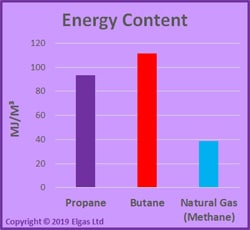 Not always true!
Not always true!
It actually depends on the unit of measure used for pricing.
If it is priced by volume — in litres — the butane has about 9% more energy content, with 27.5MJ/L versus 25.3 MJ/L for propane.
However, if it is sold by weight — in kilograms — then propane has about 5% more energy content, with 49.58MJ/kg versus 47.39 MJ/kg for butane.
Why?
Because propane has less density, you get more litres per kilogram, with the difference more than offsetting the lower MJ/L energy content value.
Butane or Propane Gas – Which is Hotter?
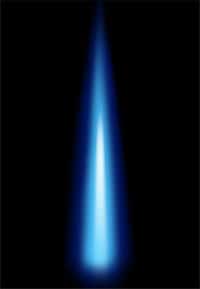 The flame temperatures of butane and propane are virtually identical.
The flame temperatures of butane and propane are virtually identical.
Butane burns at 1970°C or 3578°F.
Propane burns at 1967°C or 3573°F.
Butane Combustion
Assuming complete combustion, you get carbon dioxide and water:
2 C4H10 + 13 O2 → 8 CO2 + 10 H2O + Heat
However, with incomplete combustion you get carbon monoxide and water
2 C4H10 + 9 O2 → 8 CO + 10 H2O + Heat
This would typically occur if the ratio of oxygen to butane was insufficient.
Boiling Point: Turning from Liquid to Gas
Propane and butane have different boiling points — the temperature at which it goes from liquid to gas (vapour).
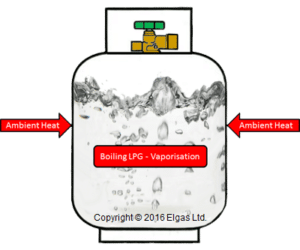 Propane boils at -42°C whereas butane boils at -0.4°C.
Propane boils at -42°C whereas butane boils at -0.4°C.
This means you have a huge problem if you try to use pure butane when the temperature drops below freezing.
No Boiling = No Vapourisation = No Gas
So, with butane only, you could find yourself with no gas for your heater and cooking appliances when it gets cold.
In some areas, LPG suppliers provide a mixture of propane and butane to address this problem.
This can work well when there are temperatures both below and above freezing.
However, the mixture in the cylinder can become butane rich if there is too much cold weather, with only the propane vapourising and being used.
Needless to say, propane is the preferred choice for cold weather climates.
What is Butane Commonly Used for?
The most common use of butane is as a heating fuel.
It can be used for cooking, hot water and space heating.
It is also frequently blended into autogas, to fuel vehicles.
There are also commercial and agricultural applications, including the heating of greenhouses.
In non-fuel applications, butane is also commonly used as a propellant in aerosol products and as a refrigerant.
More Propellant Use for Butane & Isobutane
One of the other important differences between the gases is vapour pressure.
Vapour pressure is the pressure exerted by the vapour (gas), in equilibrium with the liquid, against the walls of the cylinder or other closed container at a given temperature.
Propane has a much higher vapour pressure than either butane or isobutane.
Propane has approximately 4x the vapour pressure of butane and about 2.75x the vapour pressure of isobutane. (See properties chart above)
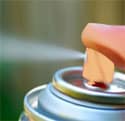 Propane, butane and isobutane are all used as propellants in aerosol products, as they are naturally odourless, non-corrosive and non-toxic.
Propane, butane and isobutane are all used as propellants in aerosol products, as they are naturally odourless, non-corrosive and non-toxic.
For obvious reasons, no odourant is added to the LPG when used as a propellant.
Nobody wants a stinky hairspray!
These gases may be used individually or in combinations to achieve the desired pressure.
The lower pressures of the two butanes tend to be favoured for everything from deodorant to disposable cigarette lighters.
When the product label lists “hydrocarbon” as the propellant, it is often butane or isobutane.
LPG gases replaced chlorofluorocarbons (CFCs) as propellants about 30 years ago.
CFCs were banned because they damaged the ozone layer of the atmosphere.
Refrigerant Applications with Butane and Isobutane
All three gases are used in refrigeration but for different applications.
They have different refrigeration uses because of their different thermodynamic properties.
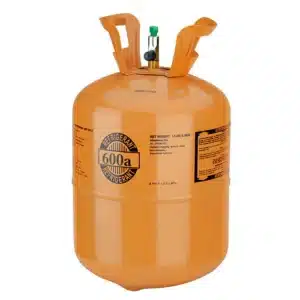 They are used to replace the harmful CFC refrigerants, such as R-12, R-22, R-134a.
They are used to replace the harmful CFC refrigerants, such as R-12, R-22, R-134a.
High purity propane (>97.5%) is used as a refrigerant, known as R290.
Both n-Butane (R-600) and i-Butane (R600a) are also used as refrigerants.
The three gases can also be mixed to achieve different properties, such as with R-290a, a mixture of isobutane and propane.
Just as with propellants, LPG gases also replaced chlorofluorocarbons (CFCs) as refrigerants, to preserve the ozone layer.
Improved Yields for Greenhouses with Butane
Butane is favoured, over propane, for use as fuel in greenhouses.
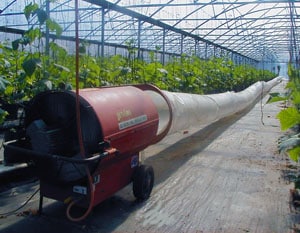 It provides both heat and enriches the atmosphere with CO2, which aids in plant growth.
It provides both heat and enriches the atmosphere with CO2, which aids in plant growth.
While both propane and butane are environmentally friendly fuels, butane does have an extra carbon atom (C4H10 vs C3H8) that results in ⅓ more CO2 when burned.
Improved yields make it the preferred choice for greenhouse use.
Butane or Propane Gas Availability Around the World
Propane is generally available in most countries.
Butane can be a bit harder to find in some areas.
Nevertheless, in many countries it is available, either as pure butane or blended with propane.
Final Thoughts
For many people, the 3 different gases are indistinguishable and never pose an issue.
However, for others they provide the flexibility to use them for various specialised applications.
Either way, they are exceptional energy products.
- Outdoor Heater: Outdoor Gas Heaters – Patio Heater Guide - September 22, 2024
- LPG Meaning – LPG Means: What Does LPG Stand For - August 31, 2024
- What Size & How Many Gas Bottles Do I Need? - August 29, 2024


